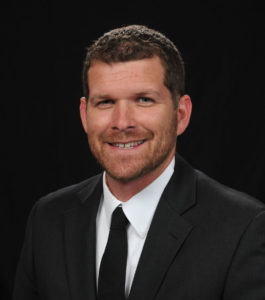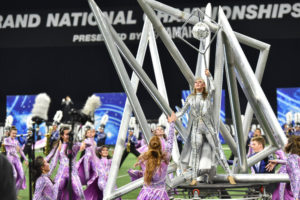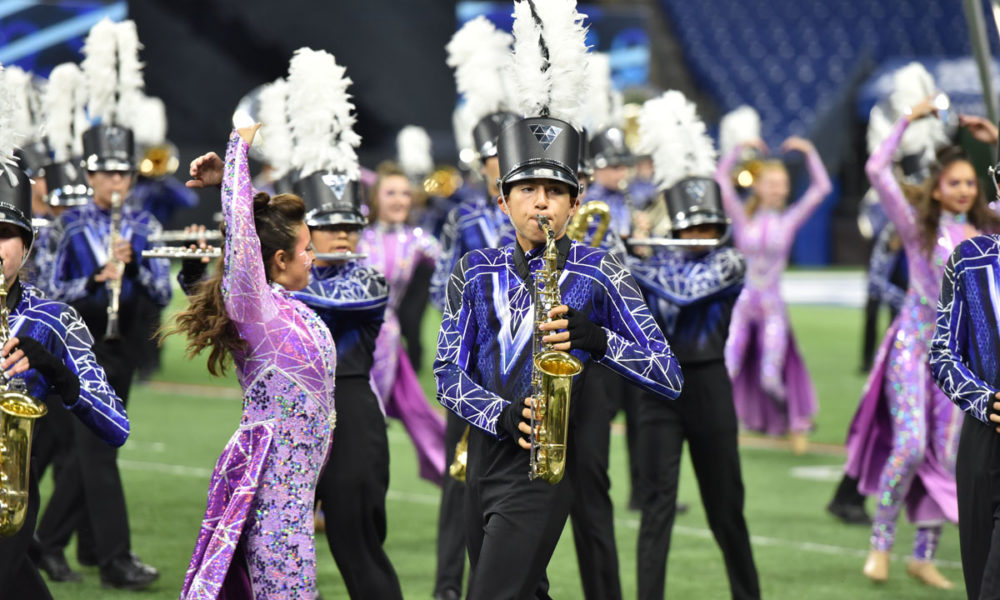The Vandegrift Band and Vision Dance Company in Austin, Texas, made its debut at Bands of America Grand Nationals in 2019 and emerged as champions.
 When Mozart composed “The Magic Flute,” he likely didn’t envision a 386-member marching band and dance company performing the famous opera. However, in its field show, “Aria Queen of the Night,” Vandegrift High School from Austin, Texas (part of the Leader, Texas, Independent School District), stole the competition for its first Bands of America (BOA) Grand National championship. Mike Howard, currently director of bands, started the program with only 42 students when the school opened in 2009 and turned it into a powerhouse. Howard reflects on the culture that leads the group to artistic excellence.
When Mozart composed “The Magic Flute,” he likely didn’t envision a 386-member marching band and dance company performing the famous opera. However, in its field show, “Aria Queen of the Night,” Vandegrift High School from Austin, Texas (part of the Leader, Texas, Independent School District), stole the competition for its first Bands of America (BOA) Grand National championship. Mike Howard, currently director of bands, started the program with only 42 students when the school opened in 2009 and turned it into a powerhouse. Howard reflects on the culture that leads the group to artistic excellence.
Halftime: What is your educational and musical background?
Howard: My dad’s a retired high school band director, so I grew up around high school band. By the time I was in high school, there wasn’t really anything else I wanted to do except be a band director. … I got a music degree at Texas State University in San Marcos and spent time performing with and teaching the Madison Scouts [Drum and Bugle Corps]. … I’ve taught high school band for 17 years, 11 here at Vandegrift High School.
Halftime: Does the band have any special traditions?
Howard: The school’s named after a fallen Marine who’s from this area that passed away in 2008. Because of that, every year that the kids are in band, they get a dog tag that has their name and the show on it. … It’s the one thing they’re allowed to wear with their uniforms. … The day we give out those dog tags is kind of a big deal, especially for the new members that are getting theirs for the first time.
Halftime: You made your debut at Bands of America Grand National Championships this year and won. Why did you pick this year to attend?
Howard: I was hesitant to have the kids pay to travel across the country to do a marching contest. Typically, our out-of-state travel is a travel experience. …
I very specifically waited until I felt like the program was ready to go up to Indianapolis [for Grand Nationals]. I wanted the students to go up and have a great experience, so I wanted to establish a record of success here with [BOA] Regionals and Super Regionals in Texas. … After it’s all said and done, I would without hesitation say that it was completely worth it from an educational standpoint and from a performance experience standpoint.
Halftime: How did you prepare for Grand Nationals?
Howard: Our goal for Grand Nationals was to be the very best version of ourselves. … From the type of music [that] I wanted the group to play to the amount of drill [that] I wanted them to do, we stayed fairly consistent within our program philosophy. …
We tried to make sure we really utilized the capabilities and artistic quality of the dancers. We don’t have a traditional color guard, and that’s different for a lot of the groups there at Grand Nationals, but we felt it could be used as a strength to be up there doing something different. …
We are bound by an eight-hour [rehearsal] rule here in Texas. We use seven of those eight hours a week, and we have to get a lot done in a short amount of time. When we get into a rehearsal setting, it’s pretty intense, and it’s pretty fast, and the expectations for the individual student are really high. …
 Halftime: Can you describe the show and how you developed it?
Halftime: Can you describe the show and how you developed it?
Howard: When we develop our shows, I would call it a music-first concept. … It’s worked better with us in the past to start with a musical arc and see if it sparks visual creativity. … The goal of the whole show was just to have abstract artwork of Mozart on the field with an obvious visual strong female protagonist.
Halftime: Vandegrift was one of six finalists from Texas. Is there a collaborative or competitive spirit between the Texas bands?
Howard: Up at Grand Nationals, there was a really neat camaraderie between all the Texas bands. We were all kind of in the same area of the convention center, and the students spent a lot of time together. It was neat to see them all on the same team.
Halftime: Do you have any advice for other directors or musicians?
Howard: I think if they’re defining success with competitive results, they’re never truly going to feel successful. … My goal for the students is for their best moment to be immediately after they perform, not immediately after results are read. …
Halftime: How do you work to establish that kind of culture within the band?
Howard: One of our mantras with the band program [is], “The only thing you control is how hard you work.”
From day one, we try not to let the competitive aspect of what we’re doing creep in. In the end, it’s an artistic activity. …
Halftime: With that said, how did it feel to actually win?
Howard: After the finals show, the kids were emotional basket cases—in a good way. … When retreat happened, and they found out they won, that was pretty shocking. It was icing on the cake of a really special season.
Halftime: Vandegrift was also just announced as a recipient of the John Philip Sousa Foundation’s Sudler Shield. What does this award mean to the program?
Howard: It is such an outstanding honor for the students to be recognized by the John Philip Sousa Foundation. I have so much respect for the Sudler Shield Committee and its purpose of promoting music education and recognizing excellence. I couldn’t be happier for the students and community to receive this award!
Halftime: What’s next for Vandegrift?
Howard: I want to continue to seek out life-changing experiences that the students can get through performance … and continue to grow the program, so that we can influence as many students as we can.
About the Author
Kacie Brown was a member of the Broken Arrow (Oklahoma) High School band from 2012 to 2016. She is now pursuing a Bachelor of Music degree in saxophone performance with a certificate in journalism at Indiana University. In 2019, she won the inaugural Elise Hall Competition for Emerging Saxophonists. She regularly performs with the Kanaderu Saxophone Quartet.
We featured Vandegrift’s first drum major, Caitlin Hall, in this article.


